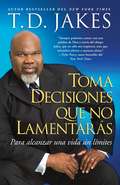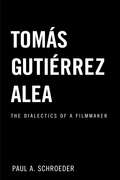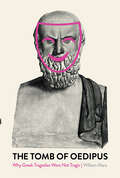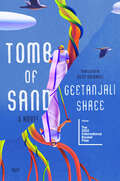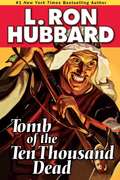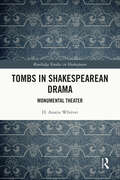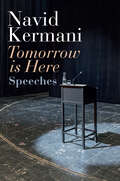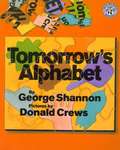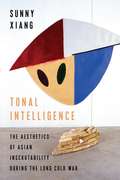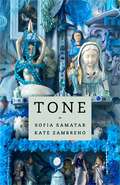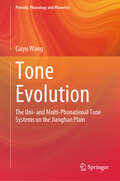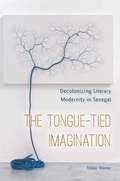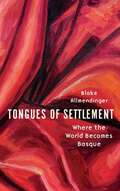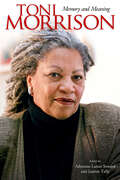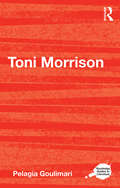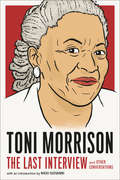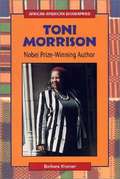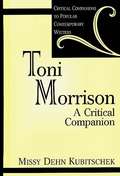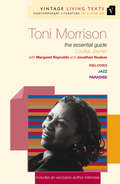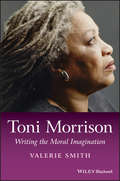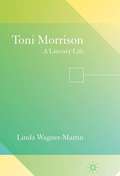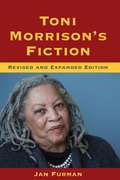- Table View
- List View
Toma decisiones que no lamentars (Making Grt Decisions; Span)
by T. D. JakesEste libro servirÁ de guÍa a quienes quieran tomar la decisiÓn correcta--ya sea en el matrimonio, los estudios o la compra de una casa--escrito por el renombrado pastor, autor y hombre de negocios, T.D.Jakes.Para sus lectores, T.D. Jakes no es tan solo un predicador: tambiÉn les proporciona las herramientas prÁcticas y psicolÓgicas que necesitan para impulsar la fe en su vidas. Claro, realista y espiritualmente vibrante, Antes de decidir es uno de esos libros singulares que logran cambiar vidas. "Recuerda", escribe T.D. Jakes, "tu maÑana es el producto de las decisiones que tomas hoy". seguir para lograr una relación amorosa, un matrimonio y una familia firmes y duraderos.
Tomas Gutierrez Alea: The Dialectics of a Filmmaker
by Paul A. SchroederFirst Published in 2003. Routledge is an imprint of Taylor & Francis, an informa company.
The Tomb of Oedipus: Why Greek Tragedies Were not Tragic
by Wililam MarxNearly Everything We Think We Know about Greek Tragedy Is WrongIf Greek tragedies are meant to be so tragic, why do they so often end so well? Here starts the story of a long and incredible misunderstanding. Out of the hundreds of tragedies that were performed, only 32 were preserved in full. Who chose them and why? Why are the lost ones never taken into account? This extremely unusual scholarly book tells us an Umberto Eco-like story about the lost tragedies. By arguing that they would have given a radically different picture, William Marx makes us think in completely new ways about one of the major achievements of Western culture. In this very readable, stimulating, lively, and even sometimes funny book, he explores parallels with Japanese theatre, resolves the enigma of catharsis, sheds a new light on psychoanalysis. In so doing, he tells also the story of the misreadings of our modernity, which disconnected art from the body, the place, and gods. Two centuries ago philosophers transformed Greek tragedies into an ideal archetype, now they want to read them as self-help handbooks, but all are equally wrong: Greek tragedy is definitely not what you think, and we may never understand it, but this makes it matter all the more to us.
Tomb of Sand
by Geetanjali ShreeA playful, feminist, and utterly original epic set in contemporary northern India, about a family and the inimitable octogenarian matriarch at its heart. <p><p> “A tale tells itself. It can be complete, but also incomplete, the way all tales are. This particular tale has a border and women who come and go as they please. Once you’ve got women and a border, a story can write itself . . .” <p><p> Eighty-year-old Ma slips into a deep depression after the death of her husband. Despite her family’s cajoling, she refuses to leave her bed. Her responsible eldest son, Bade, and dutiful, Reebok-sporting daughter-in-law, Bahu, attend to Ma’s every need, while her favorite grandson, the cheerful and gregarious Sid, tries to lift her spirits with his guitar. But it is only after Sid’s younger brother—Serious Son, a young man pathologically incapable of laughing—brings his grandmother a sparkling golden cane covered with butterflies that things begin to change. <p><p> With a new lease on life thanks to the cane’s seemingly magical powers, Ma gets out of bed and embarks on a series of adventures that baffle even her unconventional feminist daughter, Beti. She ditches her cumbersome saris, develops a close friendship with a hijra, and sets off on a fateful journey that will turn the family’s understanding of themselves upside down. <p><p> Rich with fantastical elements, folklore, and exuberant wordplay, Geetanjali Shree’s magnificent novel explores timely and timeless topics, including Buddhism, global warming, feminism, Partition, gender binary, transcending borders, and the profound joys of life. Elegant, heartbreaking, and funny, it is a literary masterpiece that marks the American debut of an extraordinary writer. <p><p> Translated from the Hindi by Daisy Rockwell <p> Author’s name pronounced: Ghee-TAHN-juh-lee Shree
Tomb of the Ten Thousand Dead
by L. Ron HubbardAction packed and captivating tale. Captain Gordon is hired to fly a team of American anthropologists to an arid mountain region now part of Pakistan bordering the Arabian Sea. All goes well until an ancient map is discovered in an old pottery jar, revealing the site of a vast treasure that Alexander the Great was bringing to Greece from his conquest of India. More than 10,000 of Alexander's soldiers and camp followers lay buried in the high desert plains along with the loot of India--hidden in a tomb never to be reclaimed.With the map's discovery, all academic pretense is dropped. Now Gordon finds himself caught in the middle of the expedition where murder replaces scholarship as the best method to uncover the valuable hoard. ALSO INCLUDES THE ADVENTURE STORIES "PRICE OF A HAT" AND "STARCH AND STRIPES""An adventure story written in the great style adventures should be written in." --Clive Cussler* An International Book Awards Winner
Tombs in Shakespearean Drama: Monumental Theater (Routledge Studies in Shakespeare)
by H. Austin WhitverTombs in Shakespearean Drama explores the rhetorical deployment of tombs and monuments on the early modern stage, demonstrating their historiographic power and mythmaking potential. By analyzing references to tombs in plays by Shakespeare and others in conjunction with extant monuments, this volume demonstrates how these references function in two overlapping ways in period drama: monuments act as repositories of information about the past, and they allow the living to construct and preserve fictive narratives. The stage exposes the flimsy materiality of paper, placing less value on the written word than period poetry. In this way, critics have perhaps oversold as universal Shakespeare’s poetic praise of stone. Tombs within plays act as a powerful historical and narrative medium, raising the stakes to provide the stage with the illusion of permanency. Playwrights use tombs to anchor the stage action, giving a sense of lasting importance to dramatic events and combatting the ephemeral nature of the playhouse. In drama, Shakespeare and others drew on the persona preserved on tombs; this volume widens our view of how these representations interacted in the commemorative economy of early modern England. Within the playhouse, it was the tomb, not the tome, that stood as a symbol of permanence.
Tommy French: How British First World War Soldiers Turned French into Slang
by Julian Walker‘Napoo’, ‘compray’, ‘san fairy ann’, ‘toot sweet’ are anglicized French phrases that came into use on the Western Front during the First World War as British troops struggled to communicate in French. Over four years of war they created an extraordinary slang which reflects the period and brings the conflict to mind whenever it is heard today. Julian Walker, in this original and meticulously researched book, explores the subject in fascinating detail. In the process he gives us an insight into the British soldiers’ experience in France during the war and the special language they invented in order to cope with their situation. He shows how French place-names were anglicized as were words for food and drink, and he looks at what these slang terms tell us about the soldiers’ perception of France, their relationship with the French and their ideas of home. He traces the spread of ‘Tommy French’ back to the Home Front, where it was popularized in songs and on postcards, and looks at the French reaction to the anglicization of their language.
Tommy French: How British First World War Soldiers Turned French into Slang
by Julian Walker‘Napoo’, ‘compray’, ‘san fairy ann’, ‘toot sweet’ are anglicized French phrases that came into use on the Western Front during the First World War as British troops struggled to communicate in French. Over four years of war they created an extraordinary slang which reflects the period and brings the conflict to mind whenever it is heard today. Julian Walker, in this original and meticulously researched book, explores the subject in fascinating detail. In the process he gives us an insight into the British soldiers’ experience in France during the war and the special language they invented in order to cope with their situation. He shows how French place-names were anglicized as were words for food and drink, and he looks at what these slang terms tell us about the soldiers’ perception of France, their relationship with the French and their ideas of home. He traces the spread of ‘Tommy French’ back to the Home Front, where it was popularized in songs and on postcards, and looks at the French reaction to the anglicization of their language.
Tomorrow is Here: Speeches
by Navid KermaniNavid Kermani is not only one of Germany&’s most distinguished writers and public intellectuals, he is also an outstanding public speaker who mesmerizes audiences with his well-crafted sentences and turns of phrase. Whether he is speaking about the plight of refugees or delivering a eulogy at his father&’s graveside, Kermani finds words that surprise his listeners, enlighten them, provoke them, disturb them or move them to tears. As a German of Iranian descent whose parents settled in Germany, Kermani is particularly sensitive to the issues raised by migration and the perceived tensions between Islam and the West. His speeches are a powerful demonstration of how much we stand to gain by adhering to the values of openness, tolerance and mutual respect for the beliefs and practices of those from other cultures who live among us.
Tomorrow's Alphabet
by George Shannon"B is for eggs... D is for puppies...Z is for countdown..." A delightful new twist for learning the ABCs.
Tonal Intelligence: The Aesthetics of Asian Inscrutability During the Long Cold War (Literature Now)
by Sunny XiangWhy were U.S. intelligence organizations so preoccupied with demystifying East and Southeast Asia during the mid-twentieth century? Sunny Xiang offers a new way of understanding the American cold war in Asia by tracing aesthetic manifestations of “Oriental inscrutability” across a wide range of texts. She examines how cold war regimes of suspicious thinking produced an ambiguity between “Oriental” enemies and Asian allies, contributing to the conflict’s status as both a “real war” and a “long peace.”Xiang puts interrogation reports, policy memos, and field notes into conversation with novels, poems, documentaries, and mixed media work by artists such as Theresa Hak Kyung Cha, Kazuo Ishiguro, Ha Jin, and Trinh T. Minh-ha. She engages her archive through a reading practice centered on tone, juxtaposing Asian diasporans who appear similar in profile yet who differ in tone. Tonal Intelligence considers how the meaning of race, war, and empire came under pressure during two interlinked periods of geopolitical transition: American “nation-building” in East and Southeast Asia during the mid-twentieth century and Asian economic modernization during the late twentieth century. By reading both state records and aesthetic texts from these periods for their tone rather than their content, Xiang shows how bygone threats of Asian communism and emergent regimes of Asian capitalism have elicited distinct yet related anxieties about racial intelligibility. Featuring bold methods, unlikely archives, and acute close readings, Tonal Intelligence rethinks the marking and making of race during the long cold war.
Tone
by Sofia Samatar Kate ZambrenoTone is a collaborative study of literary tone, a notoriously challenging and slippery topic for criticism. Both granular and global, infusing a text with feeling, tone is so difficult to pin down that responses to it often take the vague form of “I know it when I see it.”In Tone, a cooperative authorial voice under the name of the Committee to Investigate Atmosphere begins from the premise that tone is relational, belonging to shared experience rather than a single author, and should be approached through a communal practice. In partnership, the Committee explores the atmospheres emanating from texts by Nella Larsen, W. G. Sebald, Heike Geissler, Hiroko Oyamada, Mieko Kanai, Bhanu Kapil, Franz Kafka, Renee Gladman, and others, attending to the chafing of political irritation, the hunger of precarious and temporary work, and the lonely delights of urban and suburban walks.This study treats a variety of questions: How is tone filtered through translation? Can a text hold the feelings that pass between humans and animals? What can attention to literary tone reveal about shared spaces such as factories, universities, and streets and the clashes and connections that happen there? Searching and conversational, Tone seeks immersion in literary affect to convey the experience of reading—and living—together.
Tone Evolution: The Uni- and Multi-Phonational Tone Systems on the Jianghan Plain (Prosody, Phonology and Phonetics)
by Caiyu WangThis book provides a start of defining the uni- and multi-phonational tone systems of geographically-connected dialects under a phonation-pitch tonal model. It also demonstrates an interpretation of the contemporary ongoing tonal variations and varieties from the perspective of language evolution. Acoustic data are collected from five adjacent counties on the Jianghan Plain in China, where two varieties of Southwestern Mandarin and one variety of Gan Dialect are spoken. Falsetto and breathy phonations are applied in this area for phonological distinction, and thus the modal-only dialects co-occur with the di-phonational (falsetto and modal) and tri-phonational (falsetto, modal, and breathy) ones. The acoustic and perceptual analyses are conducted to define tones under the Multi-Register Four-Level Tonal Model, a frame considering both pitch and phonation for the definition of tones. The synchronic variations and varieties within and across speakers/dialects are interpreted in the dynamic interplay of tones mainly governed by phonetic and phonological reasons. The inner-system tonal differences of individual dialectal varieties together with the general distributive patterns of tones in this area are evaluated to determine the paths of tone evolution.Fresh for it exploring the definition and linguistic meaning of the dynamic modal- and non-modal tones, the book benefits researchers with data, research methods, and insight and helps the language teachers and learners understand and learn tones with what the lexical tones really are. The book is also written for the readers curious of tones and tone languages.
The Tongue-Tied Imagination: Decolonizing Literary Modernity in Senegal
by Tobias WarnerWinner, 2021 African Literature Association First Book AwardShould a writer work in a former colonial language or in a vernacular? The language question was one of the great, intractable problems that haunted postcolonial literatures in the twentieth century, but it has since acquired a reputation as a dead end for narrow nationalism. This book returns to the language question from a fresh perspective. Instead of asking whether language matters, The Tongue-Tied Imagination explores how the language question itself came to matter. Focusing on the case of Senegal, Warner investigates the intersection of French and Wolof. Drawing on extensive archival research and an under-studied corpus of novels, poetry, and films in both languages, as well as educational projects and popular periodicals, the book traces the emergence of a politics of language from colonization through independence to the era of neoliberal development. Warner reads the francophone works of well-known authors such as Léopold Senghor, Ousmane Sembène, Mariama Bâ, and Boubacar Boris Diop alongside the more overlooked Wolof-language works with which they are in dialogue.Refusing to see the turn to vernacular languages only as a form of nativism, The Tongue-Tied Imagination argues that the language question opens up a fundamental struggle over the nature and limits of literature itself. Warner reveals how language debates tend to pull in two directions: first, they weave vernacular traditions into the normative patterns of world literature; but second, they create space to imagine how literary culture might be configured otherwise. Drawing on these insights, Warner brilliantly rethinks the terms of world literature and charts a renewed practice of literary comparison.
Tongues of Settlement: Where the World Becomes Basque
by Blake AllmendingerKnown for their cultural traditions, celebrated cuisine, and distinct language, Basque peoples originated in a small area in the Pyrenees Mountains called Euskal Herria, or the Basque Country. Over the centuries, large numbers of Basques have left their homeland to settle throughout Spain, France, North America, Latin America, and South Africa, accompanied by their unique language and literature.Tongues of Settlement traces how Basque emigrants and their descendants have adapted to the Americas by interacting with the land and people, while inscribing their presence and producing a body of literature distinct from the literature of Euskal Herria. Blake Allmendinger explores the evolving relationship between language and place, analyzing forms of remembrance used to signify the Basque presence in numerous countries, especially in the western United States, where most immigrants settled and where their descendants currently reside.Tongues of Settlement considers what eventually happens as assimilated Basques relinquish their native language yet maintain a connection to place. It includes works by Basque authors, translated into English, recounting their experiences in the American West; books by Basque American writers whose narratives are set (at least in part) in the Basque Country; popular genres published by Basque American authors; and recurrent themes in Basque American literature. In this first comprehensive study, Allmendinger traces the evolution of Basque American literature from its origins in medieval oral culture to the creation of a literary renaissance in the twenty-first century American West.
Toni Morrison: Memory and Meaning
by Adrienne Lanier Seward and Justine TallyToni Morrison: Memory and Meaning boasts essays by well-known international scholars focusing on the author’s literary production and including her very latest works—the theatrical production Desdemona and her tenth and latest novel, Home. These original contributions are among the first scholarly analyses of these latest additions to her oeuvre and make the volume a valuable addition to potential readers and teachers eager to understand the position of Desdemona and Home within the wider scope of Morrison’s career. Indeed, in Home, we find a reworking of many of the tropes and themes that run throughout Morrison’s fiction, prompting the editors to organize the essays as they relate to themes prevalent in Home.In many ways, Morrison has actually initiated paradigm shifts that permeate the essays. They consistently reflect, in approach and interpretation, the revolutionary change in the study of American literature represented by Morrison’s focus on the interior lives of enslaved Africans. This collection assumes black subjectivity, rather than argues for it, in order to reread and revise the horror of slavery and its consequences into our time. The analyses presented in this volume also attest to the broad range of interdisciplinary specializations and interests in novels that have now become classics in world literature. The essays are divided into five sections, each entitled with a direct quotation from Home, and framed by two poems: Rita Dove’s “The Buckeye” and Sonia Sanchez’s “Aaayeee Babo, Aaayeee Babo, Aaayeee Babo.”
Toni Morrison (Routledge Guides to Literature)
by Pelagia GoulimariToni Morrison's visionary explorations of freedom and identity, self and community, against the backdrop of African American history have established her as one of the foremost novelists of her time; an artist whose seriousness of purpose and imaginative power have earned her both widespread critical acclaim and great popular success. This guide to Morrison’s work offers: an accessible introduction to Morrison’s life and historical contexts a guide to her key works and the themes and concerns that run through them an overview of critical texts and perspectives on each of Morrison’s works cross-references between sections of the guide, in order to suggest links between texts, contexts and criticism a chronology of Morrison’s life and works. Part of the Routledge Guides to Literature series, this volume is essential reading for all those beginning detailed study of Toni Morrison and seeking a guide to her work and a way into the wealth of contextual and critical material that surrounds it.
Toni Morrison: and Other Conversations (The Last Interview Series)
by Melville House&“Knowledge is what&’s important, you know? Not the erasure, but the confrontation of it.&” — TONI MORRISON In this wide-ranging collection of thought-provoking interviews — including her first and last — Toni Morrison (whom President Barrack Obama called a &“national treasure&”) details not only her writing life, but also her other careers as a teacher, and as a publisher, as well as the gripping story of her family. In fact, Morrison reveals here that her Nobel Prize-winning novels, such as Beloved and Song of Solomon, were born out of her family&’s stories — such as those of her great-grandmother, born a slave, or her father, escaping the lynch mobs of the South. With an introduction by her close friend, poet Nikki Giovani, Morrison hereby weaves yet another fascinating and inspiring narrative — that of herself.
Toni Morrison: Nobel Prize-winning Author
by Barbara KramerExamines the life and work of the successful novelist, who became the first African-American to win the Nobel Prize in Literature in 1993.
Toni Morrison: A Critical Companion
by Missy Dehn Kubitschek Kathleen Gregory KleinA part of critical companion series, this books looks at the work of contemporary author, Tony Morrison. Divided into several chapters, the work covers all of Tony Morrison's works--from "the Bluest Eye" to "Paradise."
Toni Morrison: The Essential Guide (Vintage Living Texts #14)
by Margaret Reynolds Jonathan Noakes Louisa JoynerIn Vintage Living Texts, teachers and students will find the essential guide to the works of Toni Morrison. Vintage Living Texts is unique in that it offers an in-depth interview with Toni Morrison, relating specifically to the texts under discussion. This guide deals with Morrison's themes, genre and narrative technique, and a close reading of the texts will provide a rich source of ideas for intelligent and inventive ways of approaching the novels.Also included in this guide are detailed reading plans for the novels, questions for essays and discussion, contextual material, suggested texts for complementary and comparative reading, extracts from reviews, a biography, bibliography and a glossary of literary terms. Whether a teacher, student or general reader, Vintage Living Texts gives you the chance to explore new resources and enjoy new pleasures.
Toni Morrison: Great American Writer
by Lisa Renee RhodesBiography of the famous writer who won a Nobel Prize for Literature.
Toni Morrison
by Valerie SmithThis compelling study explores the inextricable links between the Nobel laureateOCOs aesthetic practice and her political vision, through an analysis of the key texts as well as her lesser-studied works, books for children, and most recent novels. Offers provocative new insights and a refreshingly original contribution to the scholarship of one of the most important contemporary American writersAnalyzes the celebrated fiction of Morrison in relation to her critical writing about the process of reading and writing literature, the relationship between readers and writers, and the cultural contributions of African-American literatureFeatures extended analyses of MorrisonOCOs lesser-known works, most recent novels, and books for children as well as the key texts"
Toni Morrison: A Literary Life (Literary Lives #67)
by L. Wagner-MartinA reading of the oeuvre of Toni Morrison — fiction, non-fiction, and other — drawing extensively from her many interviews as well as her primary texts. The author aligns Morrison's novels with the works of Virginia Woolf and William Faulkner, assessing her works as among the most innovative, and most significant, worldwide, of the past fifty years.
Toni Morrison
by Linda Wagner-MartinIn this revised introduction to Nobel Laureate Toni Morrison's novels, Jan Furman extends and updates her critical commentary. New chapters on four novels following the publication of Jazz in 1992 continue Furman's explorations of Morrison's themes and narrative strategies. In all Furman surveys ten works that include the trilogy novels, a short story, and a book of criticism to identify Morrison's recurrent concern with the destructive tensions that define human experience: the clash of gender and authority, the individual and community, race and national identity, culture and authenticity, and the self and other. As Furman demonstrates, Morrison more often than not renders meaning for characters and readers through an unflinching inquiry, if not resolution, of these enduring conflicts. She is not interested in tidy solutions. Enlightened self-love, knowledge, and struggle, even without the promise of salvation, are the moral measure of Morrison's characters, fiction, and literary imagination. Tracing Morrison's developing art and her career as a public intellectual, Furman examines the novels in order of publication. She also decodes their collective narrative chronology, which begins in the late seventeenth century and ends in the late twentieth century, as Morrison delineates three hundred years of African American experience. In Furman's view Morrison tells new and difficult stories of old, familiar histories such as the making of Colonial America and the racing of American society. In the final chapters Furman pays particular attention to form, noting Morrison's continuing practice of the kind of "deep" novelistic structure that transcends plot and imparts much of a novel's meaning. Furman demonstrates, through her helpful analyses, how engaging such innovations can be.
